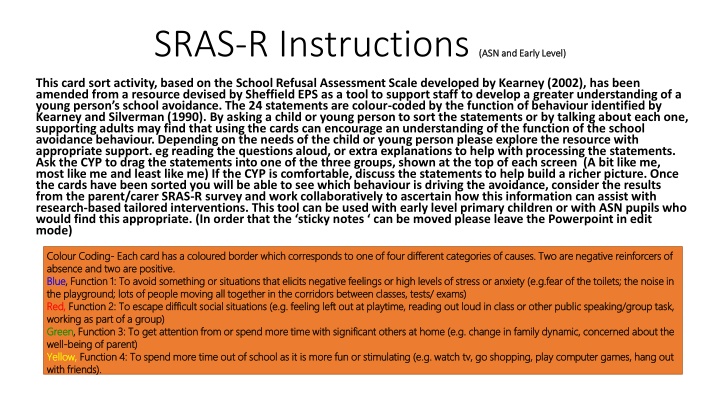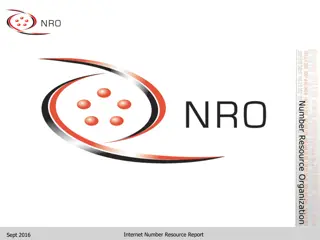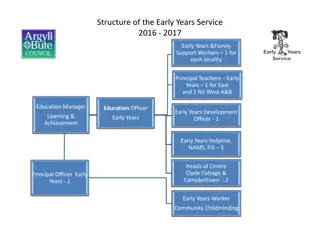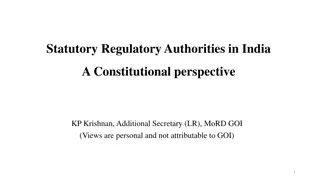
School Avoidance Behavior with SRAS-R Card Sort Activity
Explore the SRAS-R card sort activity, based on the School Refusal Assessment Scale, to understand the function of school avoidance behavior in children. Sort statements according to behavior functions and collaborate for tailored interventions.
Uploaded on | 0 Views
Download Presentation

Please find below an Image/Link to download the presentation.
The content on the website is provided AS IS for your information and personal use only. It may not be sold, licensed, or shared on other websites without obtaining consent from the author. If you encounter any issues during the download, it is possible that the publisher has removed the file from their server.
You are allowed to download the files provided on this website for personal or commercial use, subject to the condition that they are used lawfully. All files are the property of their respective owners.
The content on the website is provided AS IS for your information and personal use only. It may not be sold, licensed, or shared on other websites without obtaining consent from the author.
E N D
Presentation Transcript
SRAS-R Instructions (ASN and Early Level) (ASN and Early Level) This card sort activity, based on the School Refusal Assessment Scale developed by Kearney (2002), has been amended from a resource devised by Sheffield EPS as a tool to support staff to develop a greater understanding of a young person s school avoidance. The 24 statements are colour-coded by the function of behaviour identified by Kearney and Silverman (1990). By asking a child or young person to sort the statements or by talking about each one, supporting adults may find that using the cards can encourage an understanding of the function of the school avoidance behaviour. Depending on the needs of the child or young person please explore the resource with appropriate support. eg reading the questions aloud, or extra explanations to help with processing the statements. Ask the CYP to drag the statements into one of the three groups, shown at the top of each screen (A bit like me, most like me and least like me) If the CYP is comfortable, discuss the statements to help build a richer picture. Once the cards have been sorted you will be able to see which behaviour is driving the avoidance, consider the results from the parent/carer SRAS-R survey and work collaboratively to ascertain how this information can assist with research-based tailored interventions. This tool can be used with early level primary children or with ASN pupils who would find this appropriate. (In order that the sticky notes can be moved please leave the Powerpoint in edit mode) Colour Coding Colour Coding- - Each card has a coloured border which corresponds to one of four different categories of causes. Two are negative Each card has a coloured border which corresponds to one of four different categories of causes. Two are negative reinforcers absence and two are positive. absence and two are positive. Blue Blue, Function 1: To avoid something or situations that elicits negative feelings or high levels of stress or anxiety ( , Function 1: To avoid something or situations that elicits negative feelings or high levels of stress or anxiety (e.g.fear the playground; lots of people moving all together in the corridors between classes, tests/ exams) the playground; lots of people moving all together in the corridors between classes, tests/ exams) Red, Red, Function 2: To escape difficult social situations (e.g. feeling left out at playtime, reading out loud in class or other publ Function 2: To escape difficult social situations (e.g. feeling left out at playtime, reading out loud in class or other public ic speaking/group task, working as part of a group) working as part of a group) Green Green, Function 3: To get attention from or spend more time with significant others at home (e.g. change in family dynamic, concer , Function 3: To get attention from or spend more time with significant others at home (e.g. change in family dynamic, concerned well well- -being of parent) being of parent) Yellow, Yellow, Function 4: To spend more time out of school as it is more fun or stimulating (e.g. watch Function 4: To spend more time out of school as it is more fun or stimulating (e.g. watch tv tv, go shopping, play computer games, hang out with friends). with friends). reinforcers of of e.g.fear of the toilets; the noise in of the toilets; the noise in speaking/group task, ned about the about the , go shopping, play computer games, hang out
SRAS-R Scoring Information Please see below for instructions on how to score the child or young person's responses to the previous statements. Colour Coding- Each card has a coloured border which corresponds to one of four different categories of causes. Two are negative reinforcers of absence and two are positive. Blue, Function 1: To avoid something or situations that elicits negative feelings or high levels of stress or anxiety (e.g.fear of the toilets; the noise in the playground; lots of people moving all together in the corridors between classes, tests/ exams) Red, Function 2: To escape difficult social situations (e.g. feeling left out at playtime, reading out loud in class or other public speaking/group task, working as part of a group) Green, Function 3: To get attention from or spend more time with significant others at home (e.g. change in family dynamic, concerned about the well-being of parent) Yellow, Function 4: To spend more time out of school as it is more fun or stimulating (e.g. watch tv, go shopping, play computer games, hang out with friends). Please look to see which colour is predominant in the CYP's responses then you will be able to choose which category of behaviour is driving the avoidance. Consideration must also be given to the scoring of the parental/carer survey. This information can then assist with the selection of research-based tailored interventions. Please click on the link below for access to the parental survey. (and for the original CYP survey) https://schoolavoidance.org/school-avoidance-101/





















